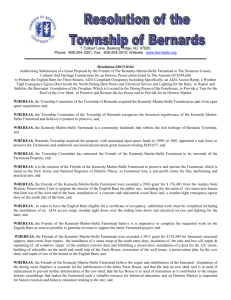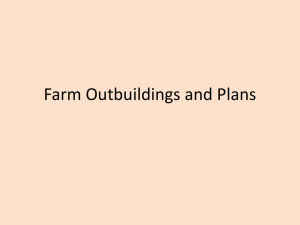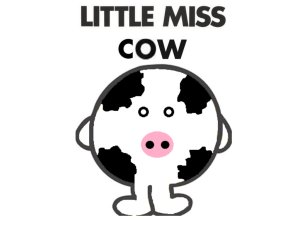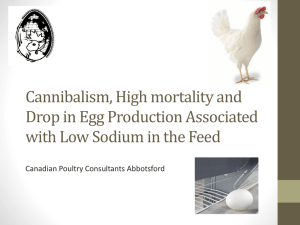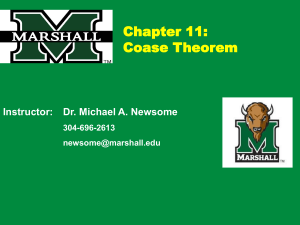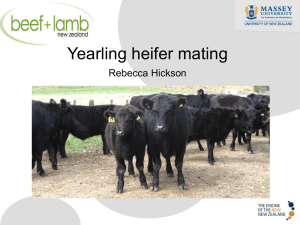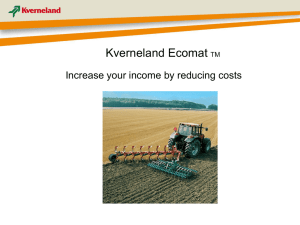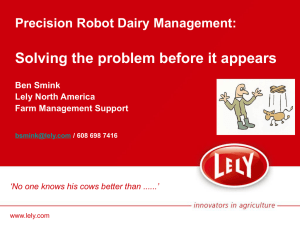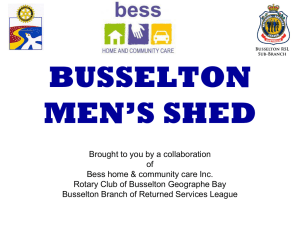The Foundations of Farmstead Planning (Read-Only)
advertisement
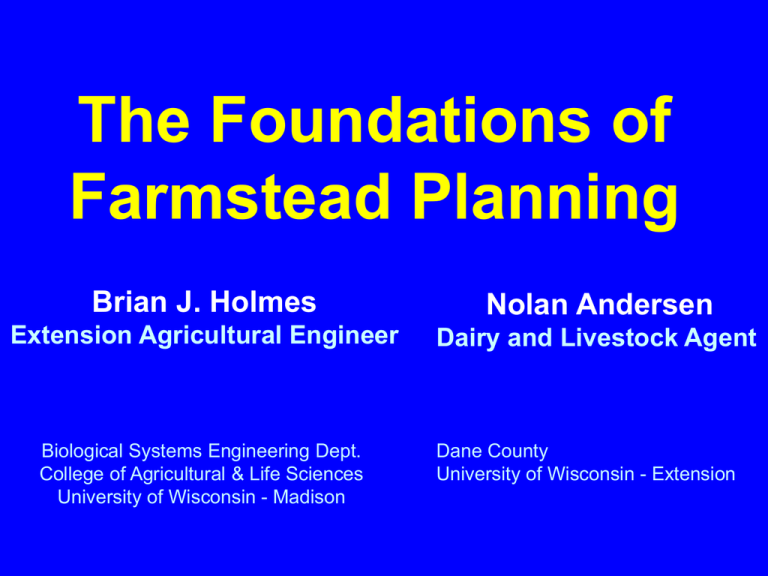
The Foundations of Farmstead Planning Brian J. Holmes Nolan Andersen Extension Agricultural Engineer Dairy and Livestock Agent Biological Systems Engineering Dept. College of Agricultural & Life Sciences University of Wisconsin - Madison Dane County University of Wisconsin - Extension Facilities Plan Promotes: 1. Labor savings 2. Natural ventilation 3. Surface drainage 4. Convenient materials handling 5. Space for expansion 6. Avoids Mistakes What is the Advisor’s Role? * Learn to listen/read between the lines * Identify the family’s vision * Identify the short term goals * Help the dairyman recognize the multitude of options * Help dairyman learn more about viable options - Identify other advisors/consultants - Visit others to view and discuss - Provide reading materials - Encourage discussions with vendors * Identify benefits and limitations of viable options * Start the planning process Steps to Dairy Modernization Write down goals Hone management skills Feasibility analysis Yes Management Land Base Economic Goals still OK? No Reconsider and rewrite goals Develop business plan Develop facilities & farmstead plans and costs Check against feasibility analysis and goals Obtain financing Contract for facilities SOME PLANNING STEPS: 1. 2. 3. 4. 5. 6. Establish Goals Learn Alternatives Discuss With Others Draw Farmstead Layout Stake The Site Drive The Site WHAT IS A FARMSTEAD PLAN? Scale Drawing - Plan View *Buildings - current - future * Well(s) * Streams * Highways * Drives * Septic(s) * North Arrow * Topographic Lines * Manure Storage * Drainage Channels * Sink Holes/Ledges * Feed Storage * Utilities * etc. FARMSTEAD PLAN = COMMUNICATION TOOL * Lender * Equipment Suppliers * Contractor * Utility Companies * Partner(s) * Subsequent Buyer * Excavator * Regulator Planning for the Future: Short Range Plan: Must be Compatible with Long Range Plan This Month’s Decisions Have an Effect for 20 – 50 Years! Planning for the Future: Overvalued facilities may unnecessarily anchor you at an existing farmstead Constraints of existing facilities may limit the technologies you can use unless you make major changes and expense. PLANNING FACTORS: 1. 2. 3. 4. 5. Adequate Water Supply Drainage Production Factors Climatic Factors Off Farm Factors Ideal Farmstead Location * Center of Land Base * Top of Hill * Distant From Streams * Distant From Neighbors * Good Source of Groundwater * Moderate-Heavy Soil Texture Build on a Knoll NOT in a Hole Diversions Diversion Prevailing Wind Directions for July About 18% % Time Calm 5% Increments Transition Facilities Needs: 1. Animal housing 2. Efficient milking 3. Feed storage/Efficient feeding 4. Manure storage - maybe EARLY 1970’S Neighbor House Machine Shed N Stall Barn Yard Neighbor House Machine Shed 1977 Stall Barn Yard Stall Barn Addition N Neighbor 1980 N Manure Storage House Machine Shed Stall Barn Silos Stall Barn Addition Neighbor Stall Barn After Fire Machine Shed 1983 N Manure Free Stall Storage Barn Silos Looking West about 1985 Stall Barn Freestall Barn House Neighbor 1987 Calf Barn Stall Barn Free Stall Barn Machine Shed N 1990 N Neighbor Neighbor Home Farm Neighbor 1991 Calf Barn Dry & Special Needs Machine Shed Free Stall N 1991 N Feed Pad 300 Free Stalls Parlor Manure Storage Neighbor Neighbor 1994 - 1995 N Bunkers 360 Free Stalls Parlor 2 Manure Storages Neighbor Neighbor 2000 - 2001 Heifers Milking & Dry & Transition w Parlor Bunkers Parlor Manure Storages Neighbor Neighbor N Material Flows What Has to Flow? Feed Water Animals Manure Milking Center Wastewater Milk Sunshine Precipitation Air Personnel Visitors Service Companies Electricity/Fuel Figure A. 50 Cow Farmstead Plan Base Case 3 2 1 0 9 8 7 6 5 Heifers 40 x 80 Machine Shed 4 3 N 2 House 1 2 3 4 5 6 7 8 9 0 1 2 3 4 5 6 7 34 x 110 Stall Barn 8 9 0 1 Figure B. 1000 Cow Farmstead Plan Phase 5 3 Commodity Shed 5 2 5 1 5 4 3 4 4 2 3 2 4 5 0 Manure Cells 320 COW FS-4 Horizontal Silos 4 2 MP HA 5 8 7 4 5 Special Needs 9 6 Heifers & Dry Cows 320 COW FS-3 5 2 5 1 Treatment Calves N 1 2 3 5 320 COW FS-5 4 1 2 Maternity 5 6 7 8 9 0 1 2 3 4 3 Treatment 5 4 2 4 4 1 House 5 6 7 2 1 8 9 0 Figure C. 100 Cow Farmstead Plan Phase 1 3 2 1 0 9 8 7 Silo Bag Pad 1 6 Special Needs 1 5 Heifers 4 1 N 1 2 3 1 100 Mature Cows & Heifers 5 6 7 8 9 0 1 2 2 1 Calf Hutch Pad 4 3 House 3 4 5 6 7 Parlor 8 9 0 1 Figure D. 200 Cow Farmstead Plan 3 Phase 2 2 1 Commodity Shed Manure Cell 0 9 2 2 2 8 Horizontal Silos 7 Silo Bag Pad 1 200 Mature Cows & Heifers 6 5 1 2 Heifers Calves 1 2 N Maternity 2 1 2 3 4 4 5 6 7 8 9 0 1 2 3 4 1 3 Parlor 2 House 5 6 7 1 8 9 0 Figure E. 300 Cow Farmstead Plan Phase 3 3 2 1 3 Commodity Shed 0 Manure Cells 9 2 3 2 2 Horizontal Silos 8 7 HA MP 6 Heifers & Dry Cows 320 COW FS-3 5 1 2 Treatment Calves 2 N 2 3 4 5 6 7 8 9 0 1 2 3 4 3 1 Maternity 2 1 4 1 Treatment House 7 2 1 8 9 0 Figure F. 600 Cow Farmstead Plan Phase 4 3 2 Commodity Shed 1 4 3 4 4 2 3 2 4 0 Manure Cells 320 COW FS-4 Horizontal Silos 9 4 2 8 HA MP 7 4 6 Heifers & Dry Cows 320 COW FS-3 5 1 2 Treatment Calves 4 N 2 3 1 2 Maternity 4 5 6 7 8 9 0 1 2 3 4 3 Treatment 4 2 1 4 1 House 5 6 7 2 1 8 9 0 Figure G. 1000 Cow Farmstead Plan Phase 5 3 2 5 5 Commodity Shed 1 5 4 3 4 4 2 3 4 5 0 Manure Cells 320 COW FS-4 Horizontal Silos HA MP 4 2 2 MP 5 8 7 4 5 Special Needs 9 6 Heifers & Dry Cows 320 COW FS-3 5 5 1 2 Treatment Calves N 4 5 320 COW FS-5 2 3 1 2 Maternity 4 5 6 7 8 9 0 1 2 3 4 3 Treatment 5 4 2 1 4 1 House 5 6 7 2 1 8 9 0 Steps to Avoid Excessive Costs: 1. Establish facility needs for 10-20 year horizon 2. Establish facility needs for the transition phase 3. Evaluate existing structures on the basis of how they can meet transition and future needs 4. Compare initial and annual costs of remodel vs new construction
